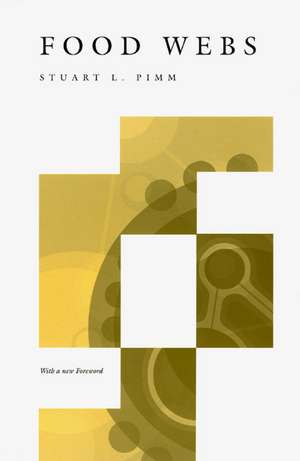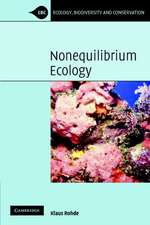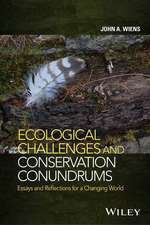Food Webs
Autor Stuart L. Pimmen Limba Engleză Paperback – 30 mai 2002
Food webs are diagrams depicting which species interact or in other words, who eats whom. An understanding of the structure and function of food webs is crucial for any study of how an ecosystem works, including attempts to predict which communities might be more vulnerable to disturbance and therefore in more immediate need of conservation.
Although it was first published twenty years ago, Stuart Pimm's Food Webs remains the clearest introduction to the study of food webs. Reviewing various hypotheses in the light of theoretical and empirical evidence, Pimm shows that even the most complex food webs follow certain patterns and that those patterns are shaped by a limited number of biological processes, such as population dynamics and energy flow. Pimm provides a variety of mathematical tools for unravelling these patterns and processes, and demonstrates their application through concrete examples. For this edition, he has written a new foreword covering recent developments in the study of food webs and demonstrates their continuing importance to conservation biology.
Although it was first published twenty years ago, Stuart Pimm's Food Webs remains the clearest introduction to the study of food webs. Reviewing various hypotheses in the light of theoretical and empirical evidence, Pimm shows that even the most complex food webs follow certain patterns and that those patterns are shaped by a limited number of biological processes, such as population dynamics and energy flow. Pimm provides a variety of mathematical tools for unravelling these patterns and processes, and demonstrates their application through concrete examples. For this edition, he has written a new foreword covering recent developments in the study of food webs and demonstrates their continuing importance to conservation biology.
Preț: 345.48 lei
Nou
Puncte Express: 518
Preț estimativ în valută:
66.11€ • 70.69$ • 55.12£
66.11€ • 70.69$ • 55.12£
Carte tipărită la comandă
Livrare economică 18 aprilie-02 mai
Preluare comenzi: 021 569.72.76
Specificații
ISBN-13: 9780226668321
ISBN-10: 0226668320
Pagini: 258
Ilustrații: 65 line drawings, 24 tables
Dimensiuni: 152 x 229 x 15 mm
Greutate: 0.37 kg
Ediția:1
Editura: University of Chicago Press
Colecția University of Chicago Press
ISBN-10: 0226668320
Pagini: 258
Ilustrații: 65 line drawings, 24 tables
Dimensiuni: 152 x 229 x 15 mm
Greutate: 0.37 kg
Ediția:1
Editura: University of Chicago Press
Colecția University of Chicago Press
Notă biografică
Stuart L. Pimm is a professor of ecology in the Center for Environmental Research and Conservation at Columbia University. He is the author of The World According to Pimm: A Scientist Audits the Earth and The Balance of Nature? Ecological Issues in the Conservation of Species and Communities, the latter oublished by the University of Chicago Press.
Cuprins
Preface
Acknowledgments
Conventions and definitions
Foreword
1Food webs
1.1What and why?
1.2Where
1.3How?
2Models and their local stablity
2.1Introduction
2.2Models
2.3Stability
2.4Summary
Appendix 2A: Taylor's expansion
Appendix 2B: An example of calculating eigenvalues
Appendix 2C: Jacobian matrices
3Stability: other definitions
3.1Introduction
3.2Global stability
3.3Species deletion stability
3.4Stability in stochastic environments
3.5Other stability criteria
3.6Summary: models and their stabilities—Is there a best buy?
4Food web compexity I: theoretical results
4.1Introduction
4.2Bounds on food web complexity: local stability
4.3Complexity and stability under large perturbations
4.4Summary of theoretical results
5Food web complexity II: empirical results
5.1Direct tests
5.2Indirect tests
5.3Summary
6The length of food chains
6.1Introduction
6.2Hypothesis A: Energy flow
6.3Hypothesis B: Size and other design constraints
6.4Hypothesis C: Optimal foraging; why are food chains so long?
6.5Hypothesis D: Dynamical contraints
6.6Summary
Appendix 6A: Drawing inferences about food web attributes
7The patterns of omnivory
7.1Models of omnivory
7.2Testing the hypothesis
7.3Summary
8Compartments
8.1Reasons for a compartmented design
8.2Testing the hypotheses: habits as compartments
8.3Testing the hypotheses: compartments within habitats
8.4Four comments
8.5Summary
9Descriptive statistics
9.1Predator-prey ratios
9.2The number of species of prey that a species exploits and the
number of species of predator it suffers
9.3Interval and non-interval food webs
9.4Summary
10Food web design: causes and consequences
10.1Introduction
10.2Causes
10.3Consequences
10.4Summary
Bibliography
Index
Acknowledgments
Conventions and definitions
Foreword
1Food webs
1.1What and why?
1.2Where
1.3How?
2Models and their local stablity
2.1Introduction
2.2Models
2.3Stability
2.4Summary
Appendix 2A: Taylor's expansion
Appendix 2B: An example of calculating eigenvalues
Appendix 2C: Jacobian matrices
3Stability: other definitions
3.1Introduction
3.2Global stability
3.3Species deletion stability
3.4Stability in stochastic environments
3.5Other stability criteria
3.6Summary: models and their stabilities—Is there a best buy?
4Food web compexity I: theoretical results
4.1Introduction
4.2Bounds on food web complexity: local stability
4.3Complexity and stability under large perturbations
4.4Summary of theoretical results
5Food web complexity II: empirical results
5.1Direct tests
5.2Indirect tests
5.3Summary
6The length of food chains
6.1Introduction
6.2Hypothesis A: Energy flow
6.3Hypothesis B: Size and other design constraints
6.4Hypothesis C: Optimal foraging; why are food chains so long?
6.5Hypothesis D: Dynamical contraints
6.6Summary
Appendix 6A: Drawing inferences about food web attributes
7The patterns of omnivory
7.1Models of omnivory
7.2Testing the hypothesis
7.3Summary
8Compartments
8.1Reasons for a compartmented design
8.2Testing the hypotheses: habits as compartments
8.3Testing the hypotheses: compartments within habitats
8.4Four comments
8.5Summary
9Descriptive statistics
9.1Predator-prey ratios
9.2The number of species of prey that a species exploits and the
number of species of predator it suffers
9.3Interval and non-interval food webs
9.4Summary
10Food web design: causes and consequences
10.1Introduction
10.2Causes
10.3Consequences
10.4Summary
Bibliography
Index
Recenzii
“Although it was first published 20 years ago . . . this book remains the clearest introduction to the study of food webs. Reviewing various hypotheses in the light of theoretical and empirical evidence, Pimm shows that even the most complex food webs follow certain patterns and that those patterns are shaped by a limited number of biological processes. . . . Pimm provides a variety of mathematical tools for unraveling these patters and processes, and demonstrates their application through concrete examples. For this edition, he has written a new foreword covering recent developments in the study of food webs and demonstrates their continuing importance to conservation biology.”
“The main body of the book stands the test of time well. Pimm writes well, and is able to convey complex ideas in a clear accessible way. . . . For many of the topics covered, for example compartmentalization and predator-prey ratios, Pimm’s text is still the most authoritative treatment available. This book remains an essential reference volume for anyone working in the field of foodweb biology.”
“This is a very nice repackaged book at a modest price. . . . I recommend it to any ecologist interested in the evolution of our views on a pertinent metric of community interaction.”












